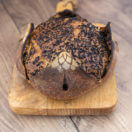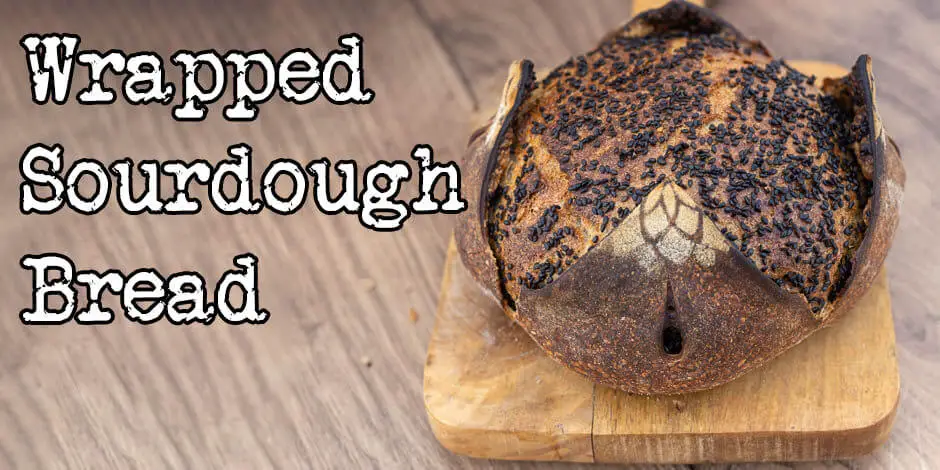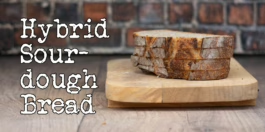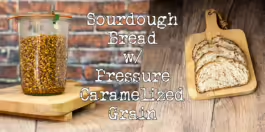Baking sourdough bread is all about the taste, right? Then you go on Instagram and scroll through your feed of your favorite bakers. There’s one gorgeous loaf after the other. Huge oven spring. Ears galore. Open crumb party. So you feel a bit discouraged. How can you make gorgeous bread? Well, you should try my wrapped sourdough bread recipe.
This kind of bread is also known as Pane Incamiciato, which in Italian means something akin to bread in a jacket. During my research of this bread, I wasn’t able to find any ‘original’ recipes or even anything about the history of this bread, so I decided to just create a recipe from scratch.
If you are just here for the recipe, you can press the button underneath to be automagically transported to the recipe:
Jump to Recipe Jump to VideoThe dough in this wrapped sourdough bread recipe
Vitals
Main Dough
| Total weight | 1100 grams |
| Pre-fermented flour | 9.2% |
| Hydration | 75.2% |
| Yield | 1 small loaf |
Outer Layer
| Total weight | 600 grams |
| Pre-fermented flour | 9.2% |
| Hydration | 56.2% |
| Yield | 1 outer layer |
Dough
Main Dough
The main dough here is just blatantly stolen from my no-knead artisan bread. You can use any sourdough bread recipe that you know and like.
This dough uses 80% bread flour for structure and 20% rye flour for excellent taste.
The hydration is sitting at 75%, which is in the high range. If your bread flour isn’t very absorbent or you are new-ish in the sourdough baking game, you can lower it using my Bread Calculator.
The salt content is a nudge above 2%, which shouldn’t raise eyebrows. Enough to bring out the taste of the flour, but nothing too crazy.
| Weight | Ingredient | Baker's Percentage |
|---|---|---|
| 452g | bread flour | 80.1% |
| 112g | whole grain rye flour | 19.9% |
| 410g | water | 72.7% |
| 114g | starter (100% hydration) | 20.2% |
| 12g | salt | 2.1% |
If you want to play around with the formula: scale, change hydration, or quantity, you can do so here in my Bread Calculator.
Outer Layer
The outer layer will add a whole new dimension to your sourdough bread. It’s very low hydration, which helps separate it from the main dough. We’ll also use olive oil and sesame seeds to help promote the separation of the two layers.
Because the hydration is very low, the only flour used is all-purpose flour.
The hydration is 56.2%, which is low. Expect to be kneading this dough for a while to get all the flour incorporated. You don’t need to do anything else special for gluten development. It will develop during bulk fermentation.
The salt content is 2.3% which helps the outside become super crispy and also gives it a sort of cracker-like feel to it.
| Weight | Ingredient | Baker's Percentage |
|---|---|---|
| 344g | all-purpose flour | 100% |
| 178g | water | 51.7% |
| 70g | starter (100% hydration) | 20.3% |
| 8g | salt | 2.3% |
As above, you can examine or change the formula in my Bread Calculator.
The conclusion of this wrapped sourdough bread recipe
This recipe for wrapped sourdough bread is, in many ways, very easy. The hard part is not making the dough, fermenting, or even shaping it. The hard part is scoring the dough.
You need to score very carefully so that you only score the outer layer of dough. It’s all about being super nimble and only scoring lightly. You can always go over the score again afterward.
Taste-wise, this bread has an excellent taste and a wonderfully soft and moist crumb. The sesame seeds get toasted when the bread is baking, and the smell that comes off this bread is intoxicating. I adore sesame seeds.
The outer layer turns SUPER crisp, and biting into a piece of this bread is so absolutely satisfying.
The look of this bread is gorgeous and will impress people. It will make a wonderful gift.
It’s worth the effort.
Please share this recipe for wrapped sourdough bread on social media
This is my recipe for wrapped sourdough bread. If you like the recipe, please consider sharing it with like-minded bread lovers on social media.
If you make it and post it on Instagram, please tag me as @foodgeek.dk so I can see it. That would make me very happy.

Wrapped Sourdough Bread
Ingredients
Main Dough
- 452 g bread flour
- 112 g dark rye flour
- 410 g water
- 114 g sourdough starter
- 12 g salt
Outside Layer Dough
- 344 g all-purpose flour
- 178 g water
- 70 g sourdough starter
- 8 g salt
Also needed
- extra virgin olive oil
- black sesame seeds
Instructions
Mix main dough
- In a medium bowl add: 452g bread flour, 112g whole grain rye flour, and 12g salt.
- Combine the ingredients with your hands.
- Then add: 114g sourdough starter, and 410g water.
- Mix the dough until all the flour has been hydrated, then move the dough to a bulking container.
- Level the dough, and mark the top of the dough using a whiteboard marker.
- Put it away for proofing somewhere warm and let it double. We want the dough to double because we are tempering the oven spring so that the inner boule doesn’t crack while it’s baking.
Mix outside layer dough
- To a small bowl add: 344g all-purpose flour, and 8g salt
- Mix it up with your hands.
- Then add: 70g sourdough starter, and 178g water
- Then mix up the dough the best you can and dump it on your kitchen counter. Knead all the flour in.
- After kneading, just put it in a container and leave it with the main dough. It’s ready when the main dough is ready.
Divide and pre-shape
- Divide the main dough in half and shape them as boules. Not too tight or anything.
- Then let them rest on the kitchen counter for 20 minutes.
Final shaping
- Flip over the boule. Pull each side out and fold over into the middle to create tension on the dough facing the table. Then flip the dough over again and shape it with your bench scraper.
- Then grab a deep dish and add black sesame seeds.
- Brush the boule with extra virgin olive oil. We brush it and add seeds to help the separation of the two doughs.
- Using your bench scraper, flip the dough into the bowl. Get sesame seeds as far up the sides you can get.
- Put the bowl with the dough and seeds aside and prepare the other boule the same way.
Make outer dough
- Then clean your counter thoroughly. You don’t want any seeds on the outside dough while rolling it out.
- Then grab the container with the outside dough. Halve it and put one of the pieces back in the bulking container so it doesn’t dry out.
- Flour your counter and roll the dough out to a big disc.
- It should be big enough to wrap around the boule. Brush the dough with extra virgin olive oil and sprinkle on some black sesame seeds.
Wrap bread
- Then grab a bowl with a boule and move it over to the middle of the outer dough. Grab each side of the main dough and fold it towards the center.
- Wrap the outside dough loosely around the main dough, and move it to a 7-inch round banneton.
- Unwrap the outer dough and then rewrap it tightly. Use scissors to remove as much dough as needed, so you don’t get a huge bulge underneath your bread.
- Use the same procedure for the other bread.
- Then put both bannetons in bags and leave them in the fridge to retard, from eight hours to 24 hours.
Bake the bread
- When ready to bake, heat your oven to 260°C/500°F, with a baking steel and a dutch oven inside. I am using my challenger bread pan.
- Let it heat for an hour, so the steel and the dutch oven are heated all the way through.
- Grab the dough from the fridge. Dust the bottom with rice flour so it won’t stick to the peel.
- Flip it onto the peel. Put a stencil on the top center of the dough.
- You can use a little pouch made from muslin with all-purpose flour inside for easy flouring.
- Hold down the stencil covering half with your hand. Then shake the flour pouch until you can see the stencil on the dough. Then turn the dough around and flour the other half.
- Then score a big cross. Be very careful when you score it so you don’t score into the main dough. You can always go over the score afterward.
- Then do four short scores on the side.
- Take the top off the dutch oven, and put the dough inside. Then put the lid back on.
- Bake for 20 minutes, and remove the top.
- Then turn down the oven to 230°C/450°F, and bake for another 25 minutes.
- Then take the bread out and let it cool on a wire rack until it’s room temperature.
- Repeat for the other bread.









